Administrative Tribunal | Research Report
VerifiedAdded on 2022/08/12
|8
|2047
|31
AI Summary
Contribute Materials
Your contribution can guide someone’s learning journey. Share your
documents today.
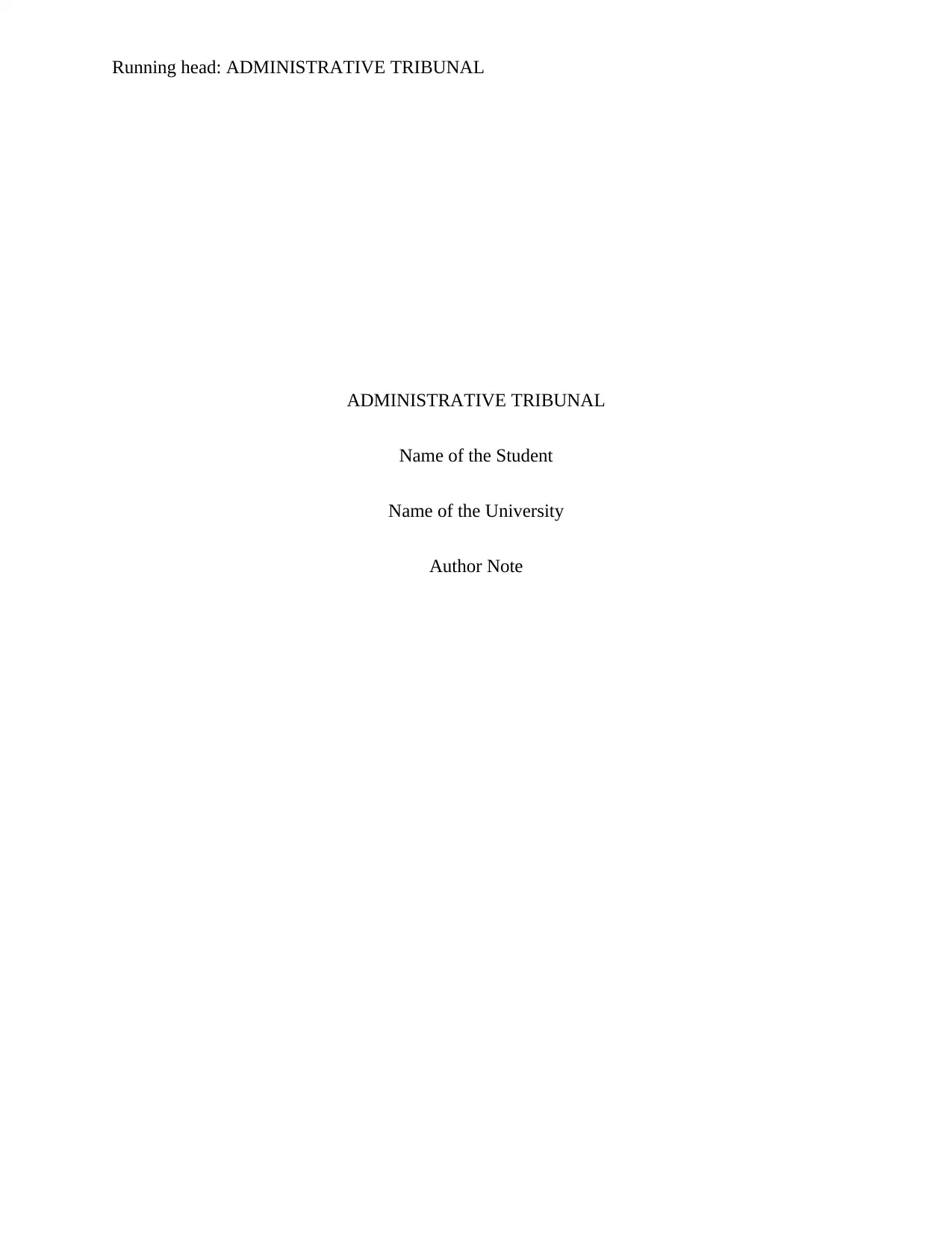
Running head: ADMINISTRATIVE TRIBUNAL
ADMINISTRATIVE TRIBUNAL
Name of the Student
Name of the University
Author Note
ADMINISTRATIVE TRIBUNAL
Name of the Student
Name of the University
Author Note
Secure Best Marks with AI Grader
Need help grading? Try our AI Grader for instant feedback on your assignments.
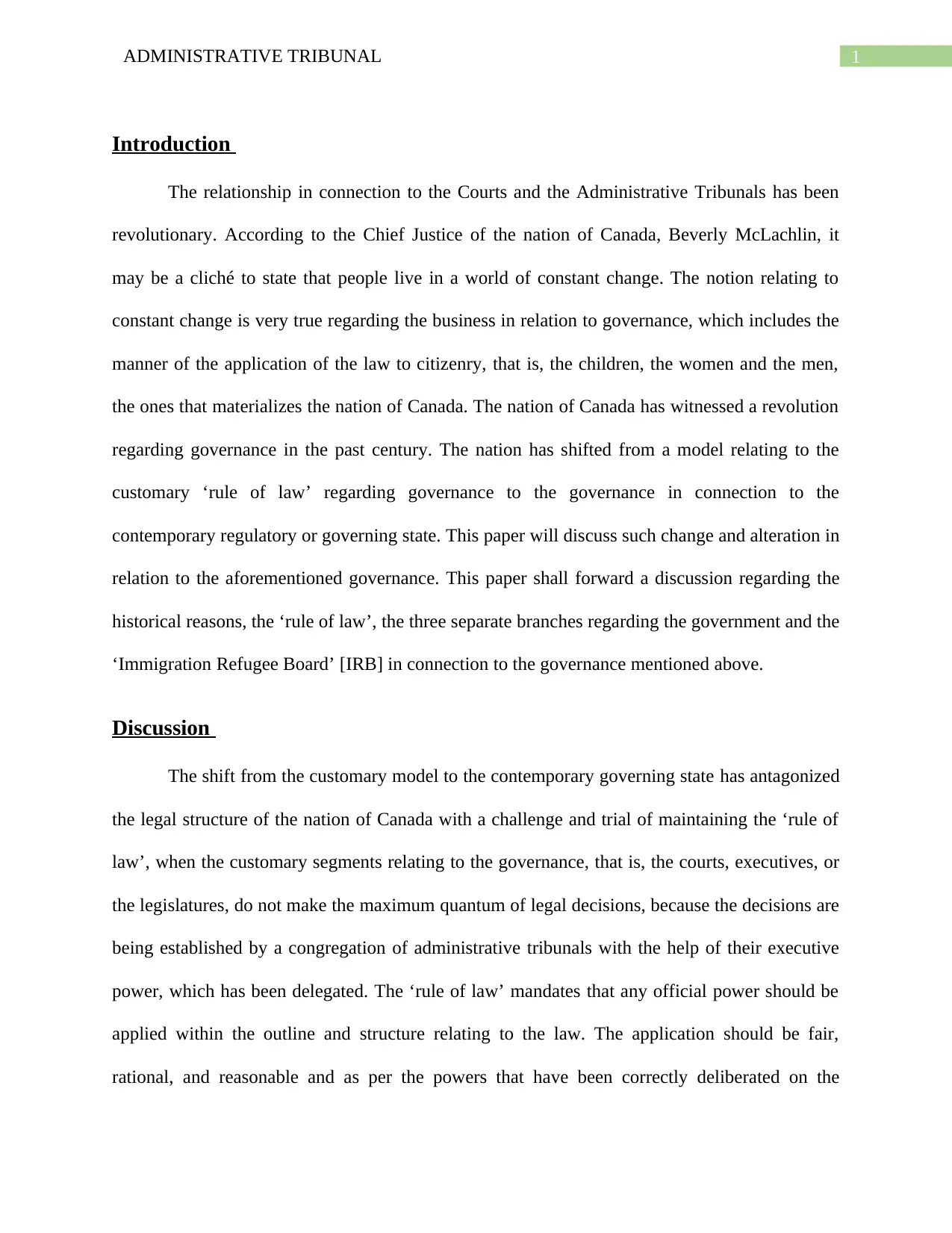
1ADMINISTRATIVE TRIBUNAL
Introduction
The relationship in connection to the Courts and the Administrative Tribunals has been
revolutionary. According to the Chief Justice of the nation of Canada, Beverly McLachlin, it
may be a cliché to state that people live in a world of constant change. The notion relating to
constant change is very true regarding the business in relation to governance, which includes the
manner of the application of the law to citizenry, that is, the children, the women and the men,
the ones that materializes the nation of Canada. The nation of Canada has witnessed a revolution
regarding governance in the past century. The nation has shifted from a model relating to the
customary ‘rule of law’ regarding governance to the governance in connection to the
contemporary regulatory or governing state. This paper will discuss such change and alteration in
relation to the aforementioned governance. This paper shall forward a discussion regarding the
historical reasons, the ‘rule of law’, the three separate branches regarding the government and the
‘Immigration Refugee Board’ [IRB] in connection to the governance mentioned above.
Discussion
The shift from the customary model to the contemporary governing state has antagonized
the legal structure of the nation of Canada with a challenge and trial of maintaining the ‘rule of
law’, when the customary segments relating to the governance, that is, the courts, executives, or
the legislatures, do not make the maximum quantum of legal decisions, because the decisions are
being established by a congregation of administrative tribunals with the help of their executive
power, which has been delegated. The ‘rule of law’ mandates that any official power should be
applied within the outline and structure relating to the law. The application should be fair,
rational, and reasonable and as per the powers that have been correctly deliberated on the
Introduction
The relationship in connection to the Courts and the Administrative Tribunals has been
revolutionary. According to the Chief Justice of the nation of Canada, Beverly McLachlin, it
may be a cliché to state that people live in a world of constant change. The notion relating to
constant change is very true regarding the business in relation to governance, which includes the
manner of the application of the law to citizenry, that is, the children, the women and the men,
the ones that materializes the nation of Canada. The nation of Canada has witnessed a revolution
regarding governance in the past century. The nation has shifted from a model relating to the
customary ‘rule of law’ regarding governance to the governance in connection to the
contemporary regulatory or governing state. This paper will discuss such change and alteration in
relation to the aforementioned governance. This paper shall forward a discussion regarding the
historical reasons, the ‘rule of law’, the three separate branches regarding the government and the
‘Immigration Refugee Board’ [IRB] in connection to the governance mentioned above.
Discussion
The shift from the customary model to the contemporary governing state has antagonized
the legal structure of the nation of Canada with a challenge and trial of maintaining the ‘rule of
law’, when the customary segments relating to the governance, that is, the courts, executives, or
the legislatures, do not make the maximum quantum of legal decisions, because the decisions are
being established by a congregation of administrative tribunals with the help of their executive
power, which has been delegated. The ‘rule of law’ mandates that any official power should be
applied within the outline and structure relating to the law. The application should be fair,
rational, and reasonable and as per the powers that have been correctly deliberated on the
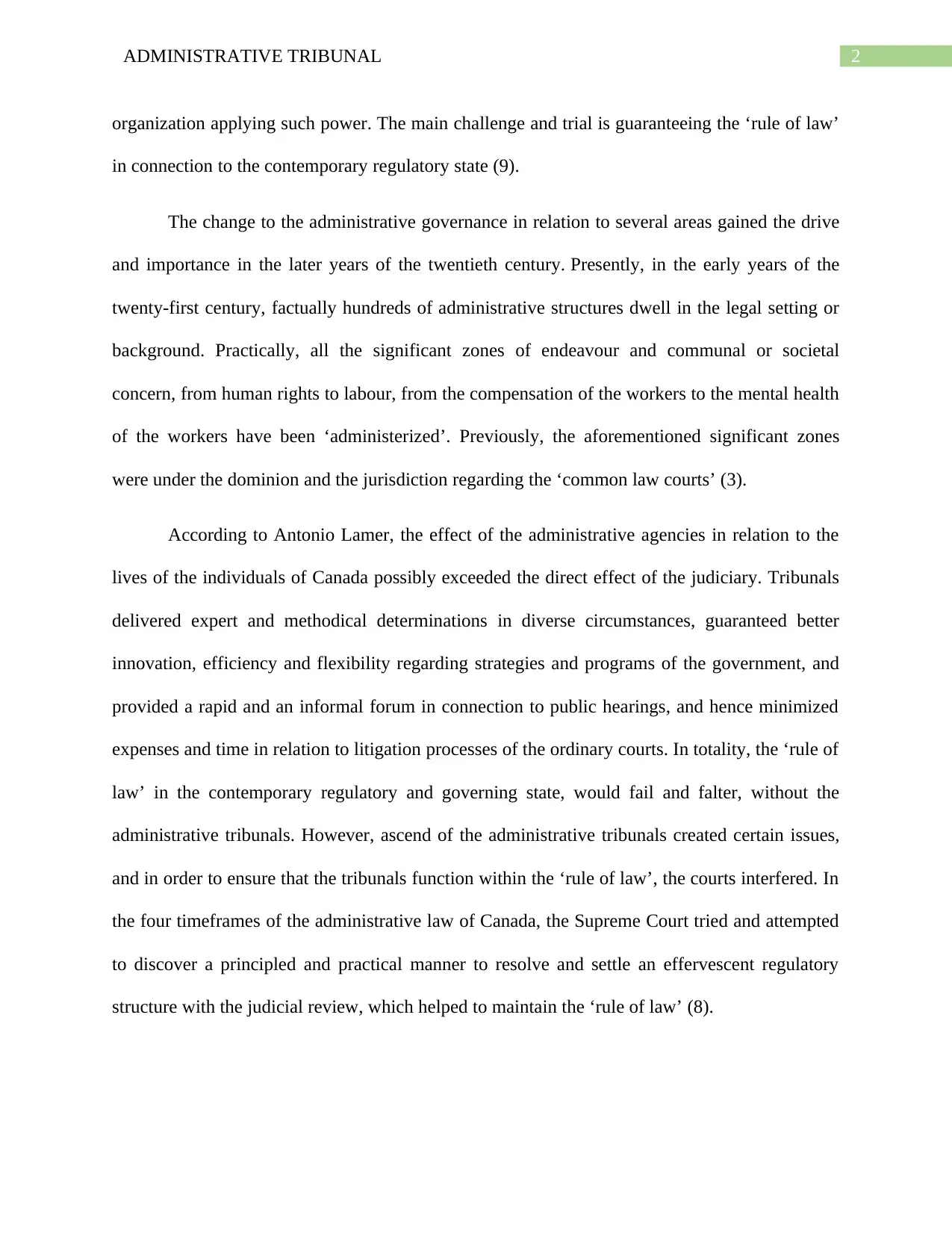
2ADMINISTRATIVE TRIBUNAL
organization applying such power. The main challenge and trial is guaranteeing the ‘rule of law’
in connection to the contemporary regulatory state (9).
The change to the administrative governance in relation to several areas gained the drive
and importance in the later years of the twentieth century. Presently, in the early years of the
twenty-first century, factually hundreds of administrative structures dwell in the legal setting or
background. Practically, all the significant zones of endeavour and communal or societal
concern, from human rights to labour, from the compensation of the workers to the mental health
of the workers have been ‘administerized’. Previously, the aforementioned significant zones
were under the dominion and the jurisdiction regarding the ‘common law courts’ (3).
According to Antonio Lamer, the effect of the administrative agencies in relation to the
lives of the individuals of Canada possibly exceeded the direct effect of the judiciary. Tribunals
delivered expert and methodical determinations in diverse circumstances, guaranteed better
innovation, efficiency and flexibility regarding strategies and programs of the government, and
provided a rapid and an informal forum in connection to public hearings, and hence minimized
expenses and time in relation to litigation processes of the ordinary courts. In totality, the ‘rule of
law’ in the contemporary regulatory and governing state, would fail and falter, without the
administrative tribunals. However, ascend of the administrative tribunals created certain issues,
and in order to ensure that the tribunals function within the ‘rule of law’, the courts interfered. In
the four timeframes of the administrative law of Canada, the Supreme Court tried and attempted
to discover a principled and practical manner to resolve and settle an effervescent regulatory
structure with the judicial review, which helped to maintain the ‘rule of law’ (8).
organization applying such power. The main challenge and trial is guaranteeing the ‘rule of law’
in connection to the contemporary regulatory state (9).
The change to the administrative governance in relation to several areas gained the drive
and importance in the later years of the twentieth century. Presently, in the early years of the
twenty-first century, factually hundreds of administrative structures dwell in the legal setting or
background. Practically, all the significant zones of endeavour and communal or societal
concern, from human rights to labour, from the compensation of the workers to the mental health
of the workers have been ‘administerized’. Previously, the aforementioned significant zones
were under the dominion and the jurisdiction regarding the ‘common law courts’ (3).
According to Antonio Lamer, the effect of the administrative agencies in relation to the
lives of the individuals of Canada possibly exceeded the direct effect of the judiciary. Tribunals
delivered expert and methodical determinations in diverse circumstances, guaranteed better
innovation, efficiency and flexibility regarding strategies and programs of the government, and
provided a rapid and an informal forum in connection to public hearings, and hence minimized
expenses and time in relation to litigation processes of the ordinary courts. In totality, the ‘rule of
law’ in the contemporary regulatory and governing state, would fail and falter, without the
administrative tribunals. However, ascend of the administrative tribunals created certain issues,
and in order to ensure that the tribunals function within the ‘rule of law’, the courts interfered. In
the four timeframes of the administrative law of Canada, the Supreme Court tried and attempted
to discover a principled and practical manner to resolve and settle an effervescent regulatory
structure with the judicial review, which helped to maintain the ‘rule of law’ (8).
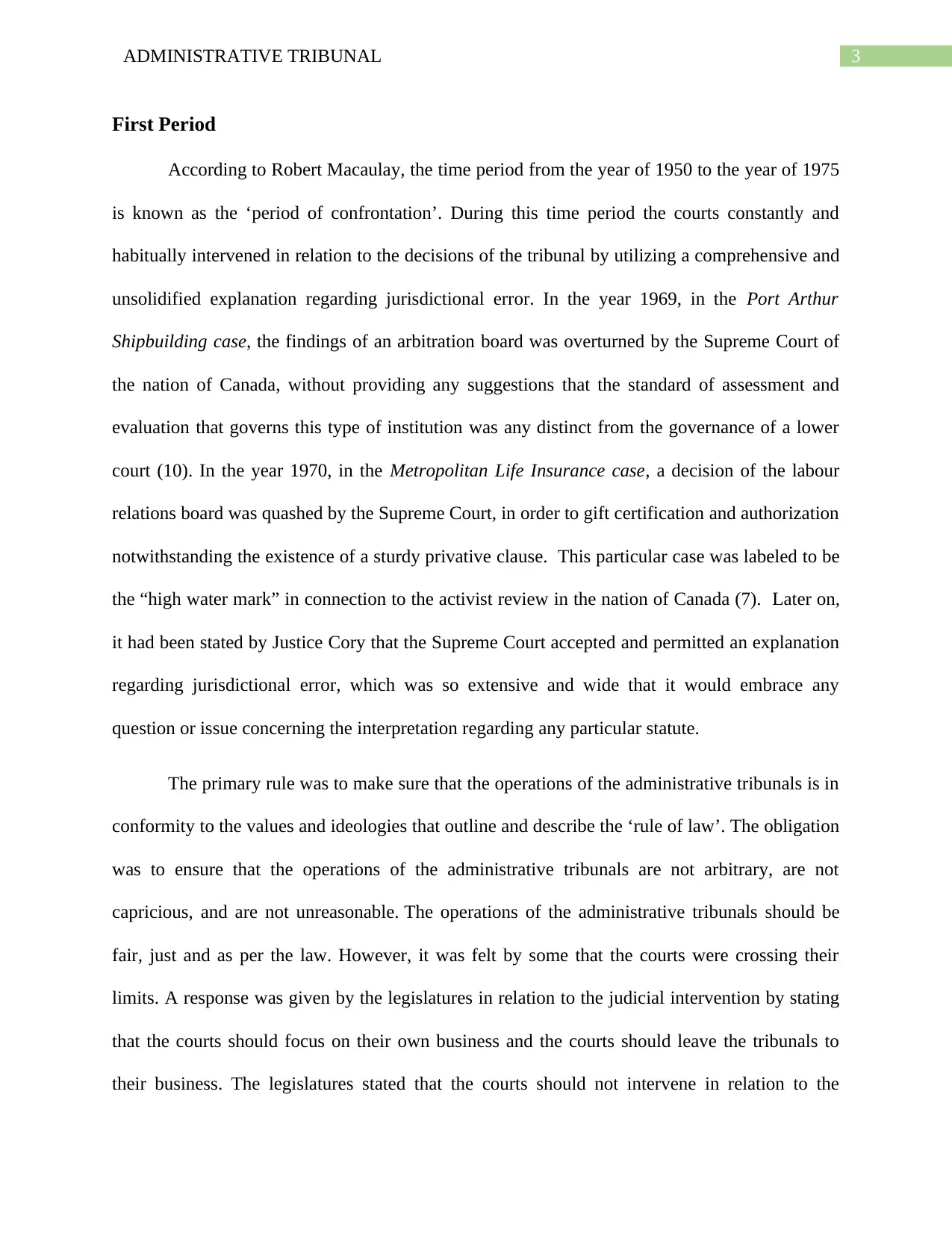
3ADMINISTRATIVE TRIBUNAL
First Period
According to Robert Macaulay, the time period from the year of 1950 to the year of 1975
is known as the ‘period of confrontation’. During this time period the courts constantly and
habitually intervened in relation to the decisions of the tribunal by utilizing a comprehensive and
unsolidified explanation regarding jurisdictional error. In the year 1969, in the Port Arthur
Shipbuilding case, the findings of an arbitration board was overturned by the Supreme Court of
the nation of Canada, without providing any suggestions that the standard of assessment and
evaluation that governs this type of institution was any distinct from the governance of a lower
court (10). In the year 1970, in the Metropolitan Life Insurance case, a decision of the labour
relations board was quashed by the Supreme Court, in order to gift certification and authorization
notwithstanding the existence of a sturdy privative clause. This particular case was labeled to be
the “high water mark” in connection to the activist review in the nation of Canada (7). Later on,
it had been stated by Justice Cory that the Supreme Court accepted and permitted an explanation
regarding jurisdictional error, which was so extensive and wide that it would embrace any
question or issue concerning the interpretation regarding any particular statute.
The primary rule was to make sure that the operations of the administrative tribunals is in
conformity to the values and ideologies that outline and describe the ‘rule of law’. The obligation
was to ensure that the operations of the administrative tribunals are not arbitrary, are not
capricious, and are not unreasonable. The operations of the administrative tribunals should be
fair, just and as per the law. However, it was felt by some that the courts were crossing their
limits. A response was given by the legislatures in relation to the judicial intervention by stating
that the courts should focus on their own business and the courts should leave the tribunals to
their business. The legislatures stated that the courts should not intervene in relation to the
First Period
According to Robert Macaulay, the time period from the year of 1950 to the year of 1975
is known as the ‘period of confrontation’. During this time period the courts constantly and
habitually intervened in relation to the decisions of the tribunal by utilizing a comprehensive and
unsolidified explanation regarding jurisdictional error. In the year 1969, in the Port Arthur
Shipbuilding case, the findings of an arbitration board was overturned by the Supreme Court of
the nation of Canada, without providing any suggestions that the standard of assessment and
evaluation that governs this type of institution was any distinct from the governance of a lower
court (10). In the year 1970, in the Metropolitan Life Insurance case, a decision of the labour
relations board was quashed by the Supreme Court, in order to gift certification and authorization
notwithstanding the existence of a sturdy privative clause. This particular case was labeled to be
the “high water mark” in connection to the activist review in the nation of Canada (7). Later on,
it had been stated by Justice Cory that the Supreme Court accepted and permitted an explanation
regarding jurisdictional error, which was so extensive and wide that it would embrace any
question or issue concerning the interpretation regarding any particular statute.
The primary rule was to make sure that the operations of the administrative tribunals is in
conformity to the values and ideologies that outline and describe the ‘rule of law’. The obligation
was to ensure that the operations of the administrative tribunals are not arbitrary, are not
capricious, and are not unreasonable. The operations of the administrative tribunals should be
fair, just and as per the law. However, it was felt by some that the courts were crossing their
limits. A response was given by the legislatures in relation to the judicial intervention by stating
that the courts should focus on their own business and the courts should leave the tribunals to
their business. The legislatures stated that the courts should not intervene in relation to the
Secure Best Marks with AI Grader
Need help grading? Try our AI Grader for instant feedback on your assignments.
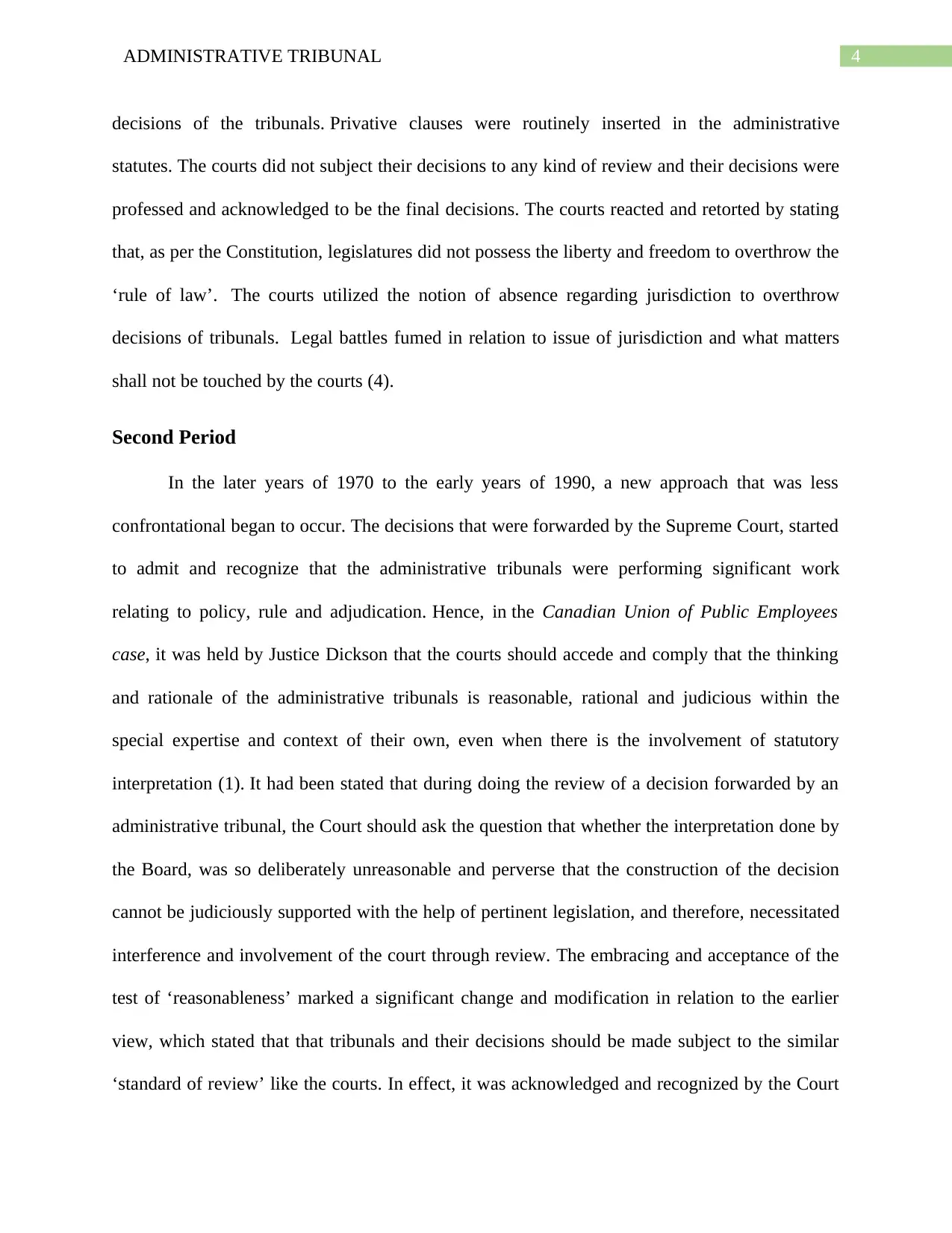
4ADMINISTRATIVE TRIBUNAL
decisions of the tribunals. Privative clauses were routinely inserted in the administrative
statutes. The courts did not subject their decisions to any kind of review and their decisions were
professed and acknowledged to be the final decisions. The courts reacted and retorted by stating
that, as per the Constitution, legislatures did not possess the liberty and freedom to overthrow the
‘rule of law’. The courts utilized the notion of absence regarding jurisdiction to overthrow
decisions of tribunals. Legal battles fumed in relation to issue of jurisdiction and what matters
shall not be touched by the courts (4).
Second Period
In the later years of 1970 to the early years of 1990, a new approach that was less
confrontational began to occur. The decisions that were forwarded by the Supreme Court, started
to admit and recognize that the administrative tribunals were performing significant work
relating to policy, rule and adjudication. Hence, in the Canadian Union of Public Employees
case, it was held by Justice Dickson that the courts should accede and comply that the thinking
and rationale of the administrative tribunals is reasonable, rational and judicious within the
special expertise and context of their own, even when there is the involvement of statutory
interpretation (1). It had been stated that during doing the review of a decision forwarded by an
administrative tribunal, the Court should ask the question that whether the interpretation done by
the Board, was so deliberately unreasonable and perverse that the construction of the decision
cannot be judiciously supported with the help of pertinent legislation, and therefore, necessitated
interference and involvement of the court through review. The embracing and acceptance of the
test of ‘reasonableness’ marked a significant change and modification in relation to the earlier
view, which stated that that tribunals and their decisions should be made subject to the similar
‘standard of review’ like the courts. In effect, it was acknowledged and recognized by the Court
decisions of the tribunals. Privative clauses were routinely inserted in the administrative
statutes. The courts did not subject their decisions to any kind of review and their decisions were
professed and acknowledged to be the final decisions. The courts reacted and retorted by stating
that, as per the Constitution, legislatures did not possess the liberty and freedom to overthrow the
‘rule of law’. The courts utilized the notion of absence regarding jurisdiction to overthrow
decisions of tribunals. Legal battles fumed in relation to issue of jurisdiction and what matters
shall not be touched by the courts (4).
Second Period
In the later years of 1970 to the early years of 1990, a new approach that was less
confrontational began to occur. The decisions that were forwarded by the Supreme Court, started
to admit and recognize that the administrative tribunals were performing significant work
relating to policy, rule and adjudication. Hence, in the Canadian Union of Public Employees
case, it was held by Justice Dickson that the courts should accede and comply that the thinking
and rationale of the administrative tribunals is reasonable, rational and judicious within the
special expertise and context of their own, even when there is the involvement of statutory
interpretation (1). It had been stated that during doing the review of a decision forwarded by an
administrative tribunal, the Court should ask the question that whether the interpretation done by
the Board, was so deliberately unreasonable and perverse that the construction of the decision
cannot be judiciously supported with the help of pertinent legislation, and therefore, necessitated
interference and involvement of the court through review. The embracing and acceptance of the
test of ‘reasonableness’ marked a significant change and modification in relation to the earlier
view, which stated that that tribunals and their decisions should be made subject to the similar
‘standard of review’ like the courts. In effect, it was acknowledged and recognized by the Court
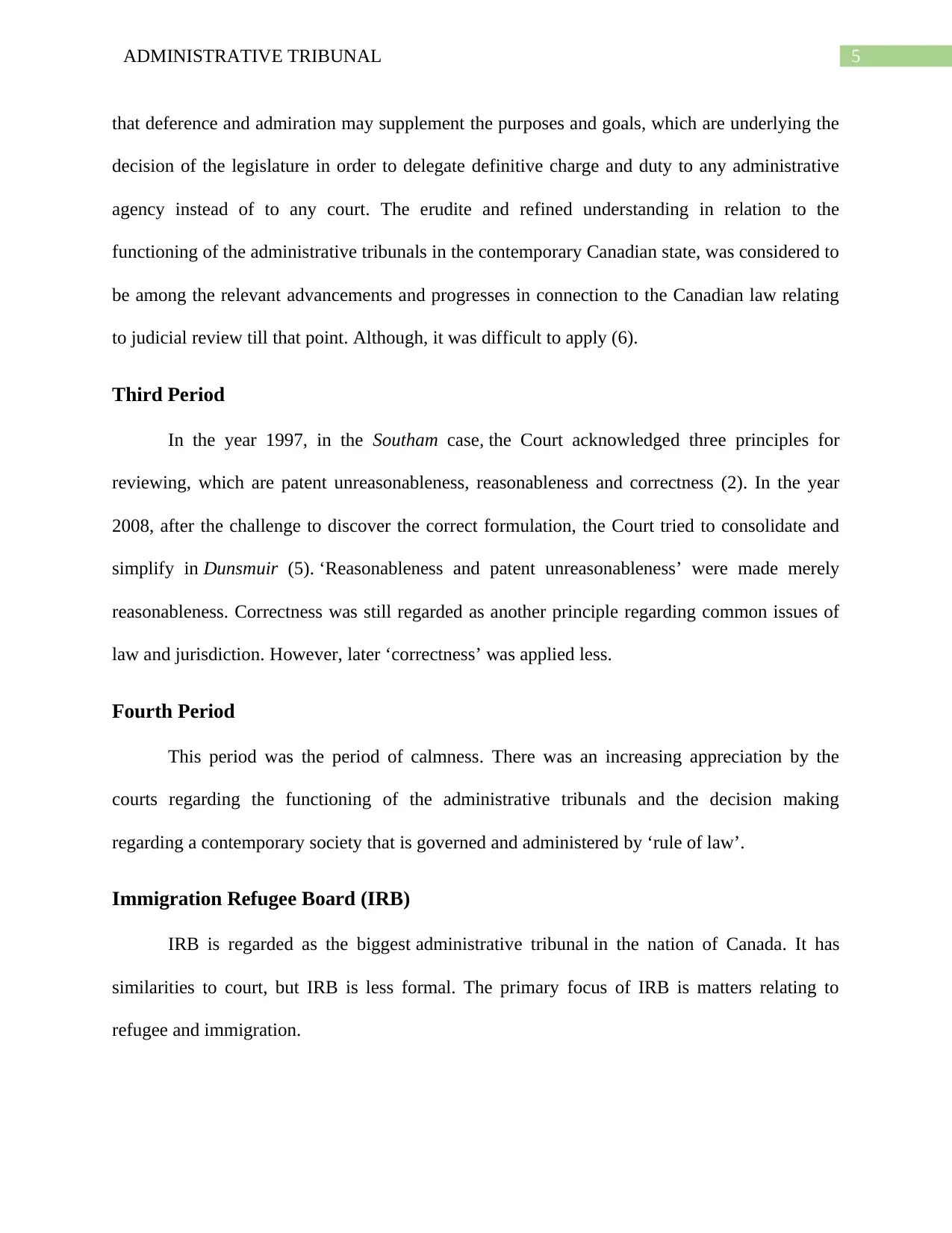
5ADMINISTRATIVE TRIBUNAL
that deference and admiration may supplement the purposes and goals, which are underlying the
decision of the legislature in order to delegate definitive charge and duty to any administrative
agency instead of to any court. The erudite and refined understanding in relation to the
functioning of the administrative tribunals in the contemporary Canadian state, was considered to
be among the relevant advancements and progresses in connection to the Canadian law relating
to judicial review till that point. Although, it was difficult to apply (6).
Third Period
In the year 1997, in the Southam case, the Court acknowledged three principles for
reviewing, which are patent unreasonableness, reasonableness and correctness (2). In the year
2008, after the challenge to discover the correct formulation, the Court tried to consolidate and
simplify in Dunsmuir (5). ‘Reasonableness and patent unreasonableness’ were made merely
reasonableness. Correctness was still regarded as another principle regarding common issues of
law and jurisdiction. However, later ‘correctness’ was applied less.
Fourth Period
This period was the period of calmness. There was an increasing appreciation by the
courts regarding the functioning of the administrative tribunals and the decision making
regarding a contemporary society that is governed and administered by ‘rule of law’.
Immigration Refugee Board (IRB)
IRB is regarded as the biggest administrative tribunal in the nation of Canada. It has
similarities to court, but IRB is less formal. The primary focus of IRB is matters relating to
refugee and immigration.
that deference and admiration may supplement the purposes and goals, which are underlying the
decision of the legislature in order to delegate definitive charge and duty to any administrative
agency instead of to any court. The erudite and refined understanding in relation to the
functioning of the administrative tribunals in the contemporary Canadian state, was considered to
be among the relevant advancements and progresses in connection to the Canadian law relating
to judicial review till that point. Although, it was difficult to apply (6).
Third Period
In the year 1997, in the Southam case, the Court acknowledged three principles for
reviewing, which are patent unreasonableness, reasonableness and correctness (2). In the year
2008, after the challenge to discover the correct formulation, the Court tried to consolidate and
simplify in Dunsmuir (5). ‘Reasonableness and patent unreasonableness’ were made merely
reasonableness. Correctness was still regarded as another principle regarding common issues of
law and jurisdiction. However, later ‘correctness’ was applied less.
Fourth Period
This period was the period of calmness. There was an increasing appreciation by the
courts regarding the functioning of the administrative tribunals and the decision making
regarding a contemporary society that is governed and administered by ‘rule of law’.
Immigration Refugee Board (IRB)
IRB is regarded as the biggest administrative tribunal in the nation of Canada. It has
similarities to court, but IRB is less formal. The primary focus of IRB is matters relating to
refugee and immigration.
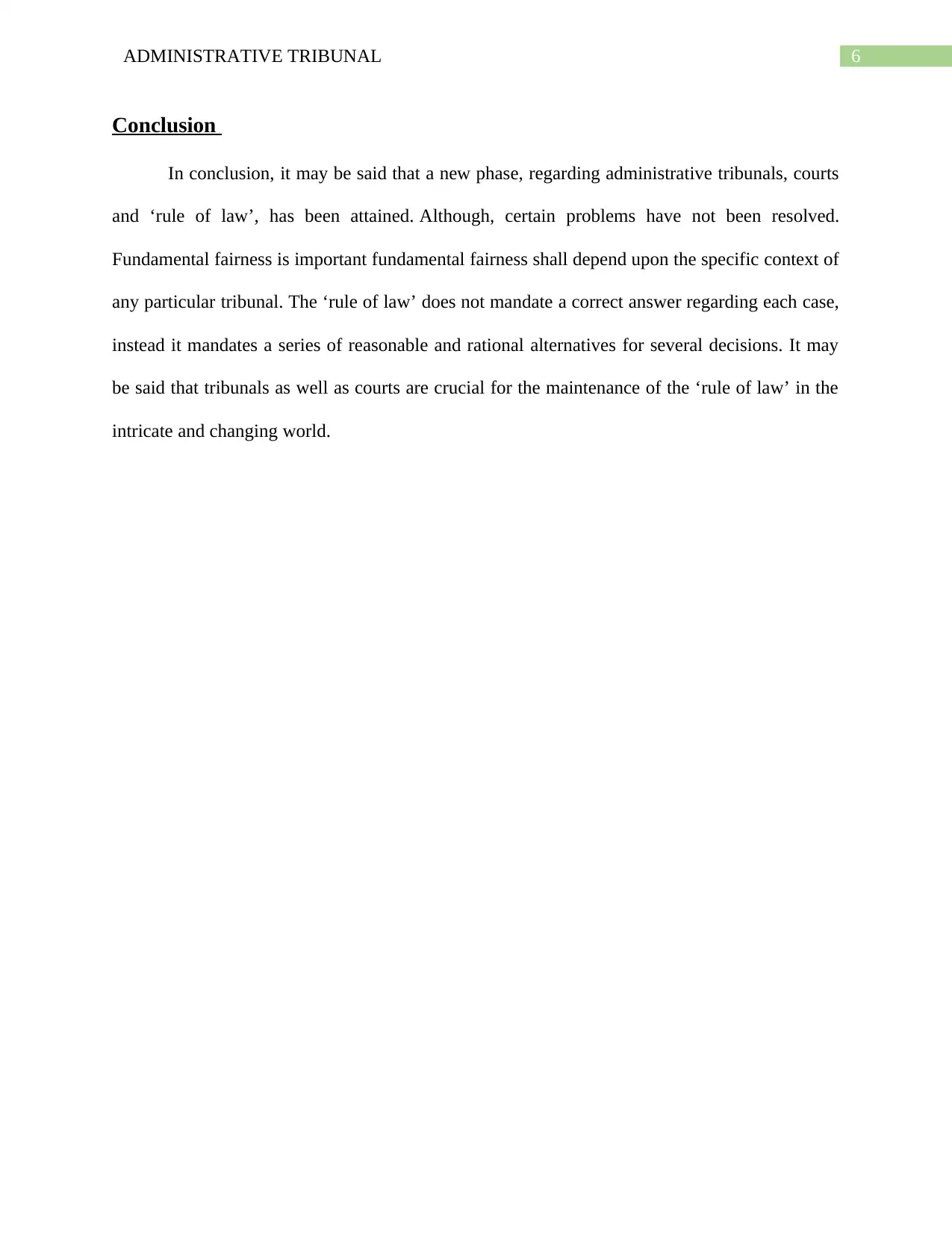
6ADMINISTRATIVE TRIBUNAL
Conclusion
In conclusion, it may be said that a new phase, regarding administrative tribunals, courts
and ‘rule of law’, has been attained. Although, certain problems have not been resolved.
Fundamental fairness is important fundamental fairness shall depend upon the specific context of
any particular tribunal. The ‘rule of law’ does not mandate a correct answer regarding each case,
instead it mandates a series of reasonable and rational alternatives for several decisions. It may
be said that tribunals as well as courts are crucial for the maintenance of the ‘rule of law’ in the
intricate and changing world.
Conclusion
In conclusion, it may be said that a new phase, regarding administrative tribunals, courts
and ‘rule of law’, has been attained. Although, certain problems have not been resolved.
Fundamental fairness is important fundamental fairness shall depend upon the specific context of
any particular tribunal. The ‘rule of law’ does not mandate a correct answer regarding each case,
instead it mandates a series of reasonable and rational alternatives for several decisions. It may
be said that tribunals as well as courts are crucial for the maintenance of the ‘rule of law’ in the
intricate and changing world.
Paraphrase This Document
Need a fresh take? Get an instant paraphrase of this document with our AI Paraphraser
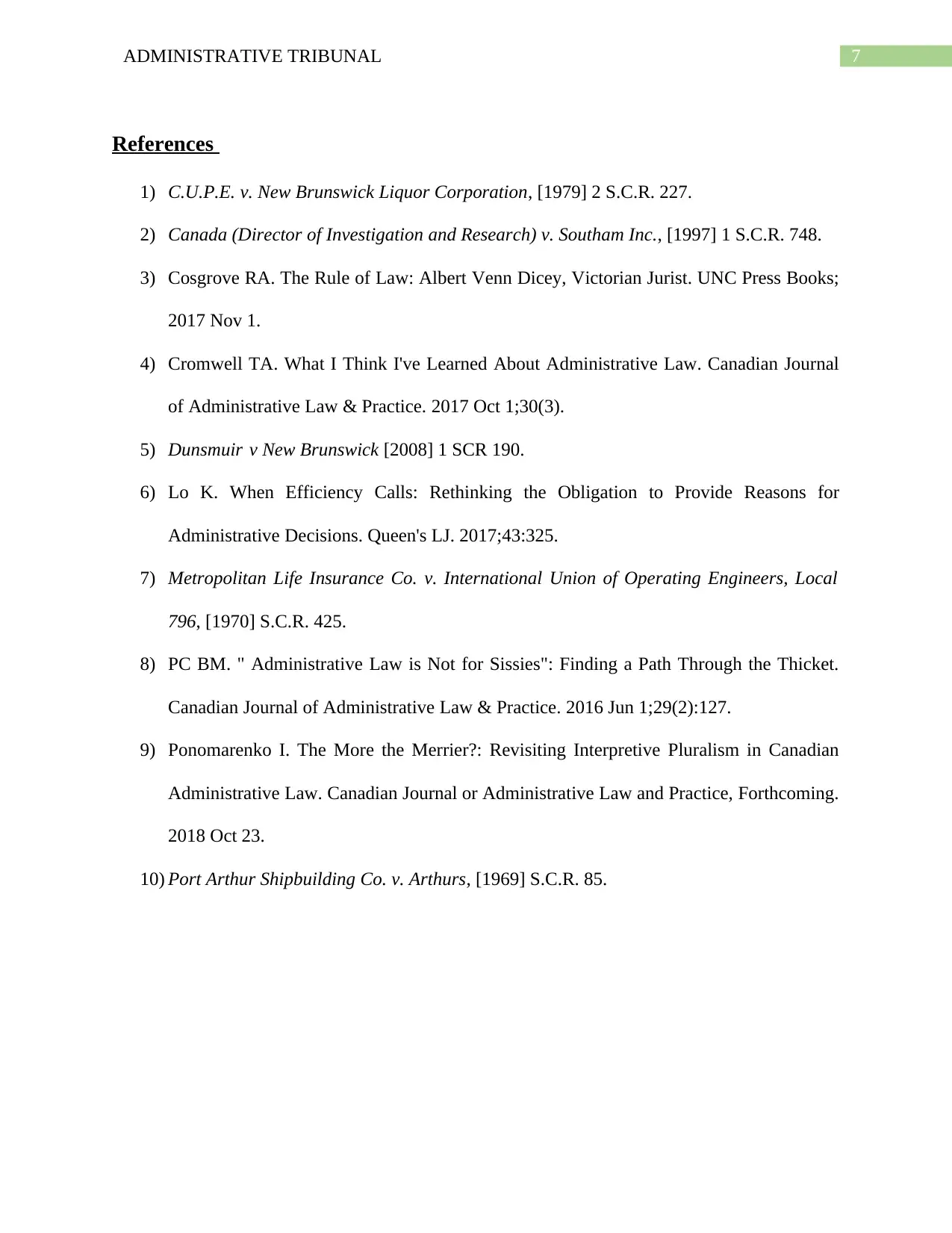
7ADMINISTRATIVE TRIBUNAL
References
1) C.U.P.E. v. New Brunswick Liquor Corporation, [1979] 2 S.C.R. 227.
2) Canada (Director of Investigation and Research) v. Southam Inc., [1997] 1 S.C.R. 748.
3) Cosgrove RA. The Rule of Law: Albert Venn Dicey, Victorian Jurist. UNC Press Books;
2017 Nov 1.
4) Cromwell TA. What I Think I've Learned About Administrative Law. Canadian Journal
of Administrative Law & Practice. 2017 Oct 1;30(3).
5) Dunsmuir v New Brunswick [2008] 1 SCR 190.
6) Lo K. When Efficiency Calls: Rethinking the Obligation to Provide Reasons for
Administrative Decisions. Queen's LJ. 2017;43:325.
7) Metropolitan Life Insurance Co. v. International Union of Operating Engineers, Local
796, [1970] S.C.R. 425.
8) PC BM. " Administrative Law is Not for Sissies": Finding a Path Through the Thicket.
Canadian Journal of Administrative Law & Practice. 2016 Jun 1;29(2):127.
9) Ponomarenko I. The More the Merrier?: Revisiting Interpretive Pluralism in Canadian
Administrative Law. Canadian Journal or Administrative Law and Practice, Forthcoming.
2018 Oct 23.
10) Port Arthur Shipbuilding Co. v. Arthurs, [1969] S.C.R. 85.
References
1) C.U.P.E. v. New Brunswick Liquor Corporation, [1979] 2 S.C.R. 227.
2) Canada (Director of Investigation and Research) v. Southam Inc., [1997] 1 S.C.R. 748.
3) Cosgrove RA. The Rule of Law: Albert Venn Dicey, Victorian Jurist. UNC Press Books;
2017 Nov 1.
4) Cromwell TA. What I Think I've Learned About Administrative Law. Canadian Journal
of Administrative Law & Practice. 2017 Oct 1;30(3).
5) Dunsmuir v New Brunswick [2008] 1 SCR 190.
6) Lo K. When Efficiency Calls: Rethinking the Obligation to Provide Reasons for
Administrative Decisions. Queen's LJ. 2017;43:325.
7) Metropolitan Life Insurance Co. v. International Union of Operating Engineers, Local
796, [1970] S.C.R. 425.
8) PC BM. " Administrative Law is Not for Sissies": Finding a Path Through the Thicket.
Canadian Journal of Administrative Law & Practice. 2016 Jun 1;29(2):127.
9) Ponomarenko I. The More the Merrier?: Revisiting Interpretive Pluralism in Canadian
Administrative Law. Canadian Journal or Administrative Law and Practice, Forthcoming.
2018 Oct 23.
10) Port Arthur Shipbuilding Co. v. Arthurs, [1969] S.C.R. 85.
1 out of 8
Related Documents
Your All-in-One AI-Powered Toolkit for Academic Success.
+13062052269
info@desklib.com
Available 24*7 on WhatsApp / Email
![[object Object]](/_next/static/media/star-bottom.7253800d.svg)
Unlock your academic potential
© 2024 | Zucol Services PVT LTD | All rights reserved.




